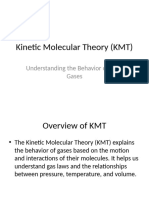0 ratings0% found this document useful (0 votes)
58 viewsKinetic Molecular Theory
Kinetic Molecular Theory
Uploaded by
Mariane HinanibanThe document discusses the kinetic molecular theory and its assumptions to explain the relationships between volume, pressure, and temperature of gases. Specifically, it states that the kinetic molecular theory can be used to investigate how (1) volume and pressure at constant temperature, (2) volume and temperature at constant pressure, and (3) these relationships can be explained by the assumptions of the kinetic molecular theory, which include that gas molecules are in constant random motion and collisions are elastic.
Copyright:
© All Rights Reserved
Available Formats
Download as PPTX, PDF, TXT or read online from Scribd
Kinetic Molecular Theory
Kinetic Molecular Theory
Uploaded by
Mariane Hinaniban0 ratings0% found this document useful (0 votes)
58 views19 pagesThe document discusses the kinetic molecular theory and its assumptions to explain the relationships between volume, pressure, and temperature of gases. Specifically, it states that the kinetic molecular theory can be used to investigate how (1) volume and pressure at constant temperature, (2) volume and temperature at constant pressure, and (3) these relationships can be explained by the assumptions of the kinetic molecular theory, which include that gas molecules are in constant random motion and collisions are elastic.
Original Description:
Class notes
Original Title
KINETIC-MOLECULAR-THEORY
Copyright
© © All Rights Reserved
Available Formats
PPTX, PDF, TXT or read online from Scribd
Share this document
Did you find this document useful?
Is this content inappropriate?
The document discusses the kinetic molecular theory and its assumptions to explain the relationships between volume, pressure, and temperature of gases. Specifically, it states that the kinetic molecular theory can be used to investigate how (1) volume and pressure at constant temperature, (2) volume and temperature at constant pressure, and (3) these relationships can be explained by the assumptions of the kinetic molecular theory, which include that gas molecules are in constant random motion and collisions are elastic.
Copyright:
© All Rights Reserved
Available Formats
Download as PPTX, PDF, TXT or read online from Scribd
Download as pptx, pdf, or txt
0 ratings0% found this document useful (0 votes)
58 views19 pagesKinetic Molecular Theory
Kinetic Molecular Theory
Uploaded by
Mariane HinanibanThe document discusses the kinetic molecular theory and its assumptions to explain the relationships between volume, pressure, and temperature of gases. Specifically, it states that the kinetic molecular theory can be used to investigate how (1) volume and pressure at constant temperature, (2) volume and temperature at constant pressure, and (3) these relationships can be explained by the assumptions of the kinetic molecular theory, which include that gas molecules are in constant random motion and collisions are elastic.
Copyright:
© All Rights Reserved
Available Formats
Download as PPTX, PDF, TXT or read online from Scribd
Download as pptx, pdf, or txt
You are on page 1of 19
MELCS:
Investigate the relationship
between:
1. volume and pressure at a constant
temperature of a gas;
2. volume and temperature at a
constant pressure of gas; and
3. explain these relationships using the
kinetic molecular theory.
The Kinetic Molecular Theory
The kinetic molecular
theory (KMT) is a model
used to describe the
behavior of gases.
Assumptions of the Kinetic
Molecular Theory of Gases
1. Gases are composed of molecules that
move in constant random motion.
a. Gas molecules are not visible to the
human eye but the effects of their
movements can be detected.
b. For example, the dust particles move
randomly in a beam of light.
Assumptions of the Kinetic
Molecular Theory of Gases
2. The molecules have no definite
volume, but they have a definite mass.
a. Gas molecules are very small and
very far apart from one another. This
causes them to take the shape of their
container.
Assumptions of the Kinetic
Molecular Theory of Gases
3. Each molecule moves in a straight line until
it collides with another molecule or the
walls of the container.
a. This, again can be detected by observing
dust particles moving in a beam of light.
b. The movement is referred to as
Brownian motion.
Assumptions of the Kinetic
Molecular Theory of Gases
4. The collision between the molecules is
completely elastic.
a. Elastic collision means no kinetic energy is
lost when the molecules collide.
b. For example, when a gas molecule with an
initial kinetic energy collides with another
gas molecule, all of the kinetic energy will
be transferred.
Assumptions of the Kinetic
Molecular Theory of Gases
5. There is no attractive force among the molecules
or between the molecules and the wall of the
container.
a. The molecules of gases have minimal to
negligible intermolecular forces of attraction.
b. This can be seen by the fact that gases expand
to achieve the shape of the container or
compressed to smaller volumes.
Assumptions of the Kinetic
Molecular Theory of Gases
6. The average kinetic energy of the gas
molecules depends only on the
temperature of the gas.
a. The higher the temperature, the
more energy is acquired by the gas
molecules allowing them to move
faster.
Kinetic Molecular Theory
Molecules move in a constant random,
and straight-line motion
No force of attraction (except during
collision)
Large spaces between molecules
Elastic collision
Constant kinetic energy at (constant
temperature)
Characteristics of Gases
All the noble gases (group 18) are monatomic
gases, whereas the other gaseous elements are
diatomic molecules. Example of these gases are
oxygen (O2), iodine (I2), chlorine (Cl2), nitrogen
(N2), and hydrogen (H2).
The volume or space occupied by the molecules
themselves is negligible as compared to the total
volume of the container so that the volume of the
container can be taken as the volume of the gas.
Characteristics of Gases
Gases are easily compressed when pressure is
applied.
Gases expand when heated and contract when
cooled.
Gases exert pressure in all directions on the walls of
their container.
Gases have lower densities than solids and liquids.
The attractive forces between molecules
(intermolecular) are negligible.
Gases mix evenly and completely when contained
in the same vessel.
Characteristics of Gases
Gases expand to fill any container.
• random motion, no attraction
Gases are fluids (like liquids).
• no attraction
Gases have very low densities.
• no volume = lots of empty space
Characteristics of Gases
Gases can be compressed.
• no volume = lots of empty space
Gases undergo diffusion & effusion.
• random motion
You might also like
- Flow of A Film On The Outside of A Circular TubeDocument6 pagesFlow of A Film On The Outside of A Circular TubeShubh100% (6)
- Investigatory Project PhyDocument11 pagesInvestigatory Project Phylavanya rajaNo ratings yet
- Science10 Q4 Week2 Limpag JuvelynDocument13 pagesScience10 Q4 Week2 Limpag Juvelynsean24131No ratings yet
- Kinetic TheoryDocument20 pagesKinetic Theorykishorkumarn8212No ratings yet
- Kinetic Theory of GasesDocument9 pagesKinetic Theory of Gasesheidyhesham3No ratings yet
- Physical Chemistry - MatterDocument8 pagesPhysical Chemistry - MatterakullopatsNo ratings yet
- The Model: The Volume Occupied by The Molecules of The Gas Is Negligible Compared To The Volume of The Gas ItselfDocument1 pageThe Model: The Volume Occupied by The Molecules of The Gas Is Negligible Compared To The Volume of The Gas ItselfSameer Singh PatelNo ratings yet
- Day 29 - GasesDocument13 pagesDay 29 - GasesAce Vincent LunaNo ratings yet
- SAMBAAN Kinetic Molecular Theory of GasesDocument22 pagesSAMBAAN Kinetic Molecular Theory of GasesTito V. Bautista Jr.No ratings yet
- GeneralChemistry - Unit 4 (Kinetic Molecular Theory)Document1 pageGeneralChemistry - Unit 4 (Kinetic Molecular Theory)Andrea Marie LaquiñaNo ratings yet
- States of MatterDocument41 pagesStates of Matterabdihakimhasssan344No ratings yet
- Kinetic Molecular TheoryDocument8 pagesKinetic Molecular TheoryDanica Dolor PingkianNo ratings yet
- Kinetic Molecular Theory - PART1Document18 pagesKinetic Molecular Theory - PART1nicole130070No ratings yet
- Properties of GasesDocument6 pagesProperties of GasesclairowrightsNo ratings yet
- Kinetic Theory Class 11 PWDocument12 pagesKinetic Theory Class 11 PWFTG GamerzNo ratings yet
- GASESDocument8 pagesGASESEvelynNo ratings yet
- Chemist RYDocument36 pagesChemist RYagubachinedu1No ratings yet
- Introduction To Kinetic Molecular TheoryDocument8 pagesIntroduction To Kinetic Molecular TheoryLyka Jade SarmientoNo ratings yet
- Unit 3Document23 pagesUnit 3Muktaar HassenNo ratings yet
- 07e61f90-aaaa-4323-ab98-25a9267db479Document1 page07e61f90-aaaa-4323-ab98-25a9267db479krishnasahuio77No ratings yet
- Properties of GasesDocument30 pagesProperties of GasesRomelyn Manalo-BelmonteNo ratings yet
- Basic Properties of GasesDocument48 pagesBasic Properties of Gaseskyon leonil MacaalayNo ratings yet
- Chemistry Grade - 11 Note - Unit - 3 (2016 E .C)Document11 pagesChemistry Grade - 11 Note - Unit - 3 (2016 E .C)bisratNo ratings yet
- Student Text 19Document25 pagesStudent Text 19astromaze10No ratings yet
- Kinetic Molecular Theory KMT PresentationDocument7 pagesKinetic Molecular Theory KMT Presentation420ahmadraza420No ratings yet
- CHM 101 - Bamisaye - 2024Document38 pagesCHM 101 - Bamisaye - 2024michaelchiemezie02No ratings yet
- 13.01 Kinetic Molecular TheoryDocument2 pages13.01 Kinetic Molecular TheoryReshma GuptaNo ratings yet
- CHE 205 Molecular Kinetic Theory of Gases-1Document10 pagesCHE 205 Molecular Kinetic Theory of Gases-1lamidiusman17proNo ratings yet
- Introduction Note 7Document1 pageIntroduction Note 7Gelena ChuiNo ratings yet
- Unit 1: Gas LawDocument17 pagesUnit 1: Gas LawDennise AguilarNo ratings yet
- Section 8.3 AnswersDocument2 pagesSection 8.3 AnswersClumley ClungNo ratings yet
- Detailed - LESSON - PLAN - GRADE 10 DemonowDocument5 pagesDetailed - LESSON - PLAN - GRADE 10 DemonowShiela Ocho100% (3)
- MODULE 1 Lesson 4 Kinteic TheoryDocument19 pagesMODULE 1 Lesson 4 Kinteic TheoryAnne Rose CoderiasNo ratings yet
- Kinetic Molecular TheoryDocument4 pagesKinetic Molecular Theoryjonalynpizon37No ratings yet
- Kinetic Molecular Theory Activity SheetDocument3 pagesKinetic Molecular Theory Activity SheetCharlieNo ratings yet
- Kinetic Molecular Theory KMT PresentationDocument7 pagesKinetic Molecular Theory KMT Presentation420ahmadraza420No ratings yet
- Properties and Behavior of Gases As Basis On Kinetic Molecular TheoryDocument3 pagesProperties and Behavior of Gases As Basis On Kinetic Molecular Theory0divide1No ratings yet
- SCI10-Lesson 11.1. Balancing ChemicalDocument35 pagesSCI10-Lesson 11.1. Balancing Chemicalmendozajesica.scuolamaria.g10No ratings yet
- Fluid Mechanics Notes: 3.2 The Kinetic Molecular TheoryDocument5 pagesFluid Mechanics Notes: 3.2 The Kinetic Molecular TheoryMilad RadNo ratings yet
- KMT ActivityDocument2 pagesKMT Activitysrd9g6jj58No ratings yet
- 4 Kinetic Molecular Theory Worksheet Key PDFDocument1 page4 Kinetic Molecular Theory Worksheet Key PDFHung TruongNo ratings yet
- 4 Kinetic Molecular Theory Worksheet KeyDocument1 page4 Kinetic Molecular Theory Worksheet KeyJennifer ValdezNo ratings yet
- Thermal Physics - Lecture 2Document22 pagesThermal Physics - Lecture 2trinhdq2015No ratings yet
- Chem Entry #4Document67 pagesChem Entry #4Vivialyn YumulNo ratings yet
- LESSON PLAN IN SCIENCE 10: Kinetic Molecular TheoryDocument4 pagesLESSON PLAN IN SCIENCE 10: Kinetic Molecular Theoryrigie.divinagraciaNo ratings yet
- Properties of Gas - de LinaDocument1 pageProperties of Gas - de LinaJana De LiñaNo ratings yet
- Kinetic Molecular Model of A GasDocument6 pagesKinetic Molecular Model of A GasUsman GhaniNo ratings yet
- Q1-M1-KMT and Gas Laws (BL)Document34 pagesQ1-M1-KMT and Gas Laws (BL)Jim AñonuevoNo ratings yet
- 9th Study of Gas Laws PDFDocument14 pages9th Study of Gas Laws PDFmovies gamesNo ratings yet
- KMT-Boyle's LawDocument38 pagesKMT-Boyle's LawAngelyn AbuevaNo ratings yet
- Factors That Affect Gas PressureDocument5 pagesFactors That Affect Gas PressureYing FlaviaNo ratings yet
- WorkSheet8787 - 2024 8 24 2728528Document17 pagesWorkSheet8787 - 2024 8 24 2728528mracim222No ratings yet
- KTG One ShotDocument58 pagesKTG One ShotashNo ratings yet
- Physical ChenistryDocument146 pagesPhysical ChenistrychemasimNo ratings yet
- Properties of GasesDocument18 pagesProperties of GasesfrancisjoycebelmonteNo ratings yet
- Unit 1 Mod 1 Kinetic Theory RevisedDocument5 pagesUnit 1 Mod 1 Kinetic Theory RevisednicoleNo ratings yet
- Chapter 3 Gases Lesson1 - 12Document97 pagesChapter 3 Gases Lesson1 - 12Julius Salas100% (1)
- Kinetic-Molecular Theory: Ideal Gas Equation PV NRTDocument9 pagesKinetic-Molecular Theory: Ideal Gas Equation PV NRTVidhuPandey100% (1)
- Kinectic Molecular TheoryDocument13 pagesKinectic Molecular TheoryKacchan's forgotten sideburnsNo ratings yet
- Daikin - Refrigeration - Malaysia - AHU - File gốcDocument26 pagesDaikin - Refrigeration - Malaysia - AHU - File gốcPhuNguyenHoangNo ratings yet
- The Controversy of Icu and IcsDocument2 pagesThe Controversy of Icu and IcsUsama AhmedNo ratings yet
- Service: Washing Machine Drum TypeDocument50 pagesService: Washing Machine Drum TypeJosé Airton TirakowskiNo ratings yet
- DC-DC Converter For EVDocument6 pagesDC-DC Converter For EVSachin AngadiNo ratings yet
- What Is The Role of MEP in CONSTRUCTION - Dhyan AcademyDocument3 pagesWhat Is The Role of MEP in CONSTRUCTION - Dhyan Academydhyanacademy engineersNo ratings yet
- Magnetic Coupling CircuitDocument37 pagesMagnetic Coupling CircuitCHAYANIN AKETANANUNNo ratings yet
- v12 Can4 MercedesDocument2 pagesv12 Can4 Mercedesecupro checoNo ratings yet
- Aalco Metals LTD Stainless Steel 1.4003 Nirosta 4003 3CR12 96Document2 pagesAalco Metals LTD Stainless Steel 1.4003 Nirosta 4003 3CR12 96Xingfeng HanNo ratings yet
- Design & Construction of River Cleaning MechanismDocument5 pagesDesign & Construction of River Cleaning MechanismInternational Journal of Innovative Science and Research Technology100% (1)
- Robin Engine EH650 EH650DA JapanDocument29 pagesRobin Engine EH650 EH650DA JapanyewlimNo ratings yet
- Yamaha P1600 Amplifier User ManualDocument42 pagesYamaha P1600 Amplifier User ManualTemistocle BNo ratings yet
- PMT200A Series Dehydrator User ManualDocument20 pagesPMT200A Series Dehydrator User Manualvilnei menegottoNo ratings yet
- Ucm03 038939 CrusherDocument1 pageUcm03 038939 CrusherEndro SuhadiNo ratings yet
- Misc Equipment ItemsDocument18 pagesMisc Equipment Itemshk168No ratings yet
- ТРЕВОГИDocument12 pagesТРЕВОГИДмитрийNo ratings yet
- Flexible Organo-Metal Halide Perovskite Solar Cells On A Ti Metal SubstrateDocument5 pagesFlexible Organo-Metal Halide Perovskite Solar Cells On A Ti Metal SubstrateHuckkey HuNo ratings yet
- Proses Wsa 2Document2 pagesProses Wsa 2Lily Diana100% (1)
- Unit 6.problem Set 2Document5 pagesUnit 6.problem Set 2Aryaa KapilNo ratings yet
- 08 Kubota 03 Series GBDocument113 pages08 Kubota 03 Series GBWere Wolf100% (6)
- Ceco Brochure PDFDocument8 pagesCeco Brochure PDFHerdi PriyoNo ratings yet
- Product Guide: Pumps and Systems For HVAC, Water Supply, Drainage and SewageDocument44 pagesProduct Guide: Pumps and Systems For HVAC, Water Supply, Drainage and SewageRoger AklNo ratings yet
- TRZ / TRZ - Ifs: Turbine Gas Meters For Custody TransferDocument4 pagesTRZ / TRZ - Ifs: Turbine Gas Meters For Custody TransferTomislav PanovNo ratings yet
- BHEL Product ProfileDocument12 pagesBHEL Product ProfileVishab FredNo ratings yet
- Precicon-R Dcsim Data Resistor MapDocument3 pagesPrecicon-R Dcsim Data Resistor Mapputul deyNo ratings yet
- 15.00 Paolo Bossi, MD, Sinai White CementDocument38 pages15.00 Paolo Bossi, MD, Sinai White CementMohd AliNo ratings yet
- GAD CondenserDocument1 pageGAD CondenserEdensonNo ratings yet
- Circuit ElementsDocument81 pagesCircuit ElementsvidulaNo ratings yet
- ., TEMPSENS: Test CertificateDocument19 pages., TEMPSENS: Test CertificateSher Bahadur VermaNo ratings yet
- Title: The Impact of Eco-Tourism: A Path To Sustainable TravelDocument15 pagesTitle: The Impact of Eco-Tourism: A Path To Sustainable TravelgungsandyarnawaNo ratings yet

























































































